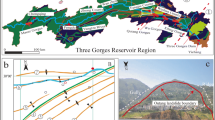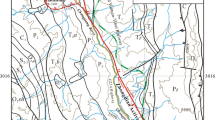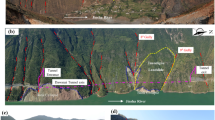Abstract
An understanding of the triggering mechanism and deformation of reservoir landslides is useful for evaluating stability and developing corresponding treatments. This study uses the Guazi landslide, a reactivated ancient landslide, as a research object. The triggering mechanism, deformation characteristics, and evolution process of the landslide are discussed based on detailed site investigations, drill holes, and various monitoring data. The results show that the reactivated zone was mainly concentrated in the lower part of the landslide area and that some surface displacements occurred in other parts, while the deeper deposits remained stable. The whole landslide underwent slow creep deformation. The Guazi landslide is a multistage topple failure landslide, and sudden increase in the reservoir level softened the lower part of the landslide; thus, significant deformation and surficial collapse occurred. At present, the reactivated landslide is stable overall; however, confirming its stability in the future is difficult.















Similar content being viewed by others
Change history
31 May 2019
The authors have retracted this article [1] because they did not have permission to publish most of the figures and data in this article.
References
Crosta GB, Prisco CD, Frattini P, Frigerio G, Castellanza R (2013) Chasing a complete understanding of the triggering mechanisms of a large rapidly evolving rockslide. Landslides 11(5):1–18
Dixon N, Spriggs MP, Smith A, Meldrum P, Haslam E (2015) Quantification of reactivated landslide behavior using acoustic emission monitoring. Landslides 12(3):549–560
Du J, Yin K, Lacasse S (2013) Displacement prediction in colluvial landslides, Three Gorges Reservoir, China. Landslides 10(2):203–218
Gu DM, Huang D, Yang WD, Zhu JL, Fu GY (2017) Understanding the triggering mechanism and possible kinematic evolution of a reactivated landslide in the Three Gorges Reservoir. Landslides 14(10):1–15
Heishui government (2018) The introduction of Heishui river. http://www.heishui.gov.cn/zjhs/
Huang D, Gu DM, Song YX, Cen DF, Zeng B (2018) Towards a complete understanding of the triggering mechanism of a large reactivated landslide in the Three Gorges Reservoir. Eng Geol 238:36–51
Jian W, Wang Z, Yin K (2009) Mechanism of the Anlesi landslide in the Three Gorges Reservoir, China. Eng Geol 108(1–2):86–95
Liu DA, Yang ZF, Tang CH, Wang J, Liu Y (2004) An automatic monitoring system for the shiplock slope of Wuqiangxi hydropower station. Eng Geol 76(1–2):79–91
Liu ZB, Xu WY, Jin HY, Liu DW (2010) Study on warning criterion for rock slope on left bank of Jinping No.1 hydropower station. J Hydraul Eng 39(1):101–107
Mantovani F, Vita-Finzi C (2003) Neotectonics of the Vajont dam site. Geomorphology 54(1–2):33–37
Miao H, Wang G, Yin K, Kamai T, Li Y (2014) Mechanism of the slow-moving landslides in Jurassic red-strata in the Three Gorges Reservoir. China Eng Geol 171(8):59–69
NMIC (2018) The annual ground data set of China (1981-2010) http://data.cma.cn/data/cdcdetail/dataCode/A.0029.0001.html (In Chinese)
Paronuzzi P, Bolla A (2012) The prehistoric Vajont rockslide: an updated geological model. Geomorphology 169-170(10):165–191
Schuster RL (1979) Reservoir-induced landslides. Bull Eng Geol Environ 20:8–15
Semenza E, Ghirotti M (2000) History of the 1963 Vajont slide: the importance of geological factors. Bull Eng Geol Environ 59(2):87–97
Sun G, Zheng H, Huang Y, Li C (2016) Parameter inversion and deformation mechanism of Sanmendong landslide in the Three Gorges Reservoir region under the combined effect of reservoir water level fluctuation and rainfall. Eng Geol 205:133–145
Wang F, Wang G, Sassa K, Takeuchi A, Araiba K, Zhang Y (2005) Displacement monitoring and physical exploration on the Shuping landslide reactivated by impoundment of the Three Gorges Reservoir, China. Landslides, pp 313–319
Wang J, Xiang W, Lu N (2014) Landsliding triggered by reservoir operation: a general conceptual model with a case study at Three Gorges Reservoir. Acta Geotech 9(5):771–788
Wolter A, Stead D, Ward BC, Clague JJ, Ghirotti M (2016) Engineering geomorphological characterization of the Vajont slide, Italy, and a new interpretation of the chronology and evolution of the landslide. Landslides 14(9):1–15
Yin YP, Wang H, Gao Y, Li X (2010) Real-time monitoring and early warning of landslides at relocated Wushan town, the Three Gorges Reservoir, China. Landslides 7(3):339–349
Yin YP, Huang BL, Wang WP, Wei YJ, Ma XH, Ma F, Zhao CJ (2016) Reservoir-induced landslides and risk control in Three Gorges Project on Yangtze river, China. J Rock Mech Geotech Eng 8(5):577–595
Zhao X, Luo Z (1975) Layout and technical innovation of aggregate processing system of Jinping I hydropower station. Nature 253(5494):694–698
Zhou S, Xie H (2011) The design of three gorges hydropower station. Eng Sci 09(3):66–73
Funding
This study has been supported by the National Key Research and Development Program of China (Grant No. 2017YFC1501000), the National Natural Science Foundation of China (Grant No. 41877235), the Funds for Creative Research Groups of China (Grant No. 41521002), and the Independent Fund of State Key Laboratory of Geohazard Prevention and Geoenvironment Protection (Grant No. SKLGP2015Z001); the authors express their gratitude for the financial assistance.
Author information
Authors and Affiliations
Corresponding authors
Additional information
The authors have retracted this article because they did not have permission to publish most of the figures and data in this article. All authors agree to this retraction.
About this article
Cite this article
Zhao, B., Wang, Y., Wang, Y. et al. RETRACTED ARTICLE: Triggering mechanism and deformation characteristics of a reactivated ancient landslide, Sichuan Province, China. Landslides 16, 383–393 (2019). https://doi.org/10.1007/s10346-018-1111-0
Received:
Accepted:
Published:
Issue Date:
DOI: https://doi.org/10.1007/s10346-018-1111-0




